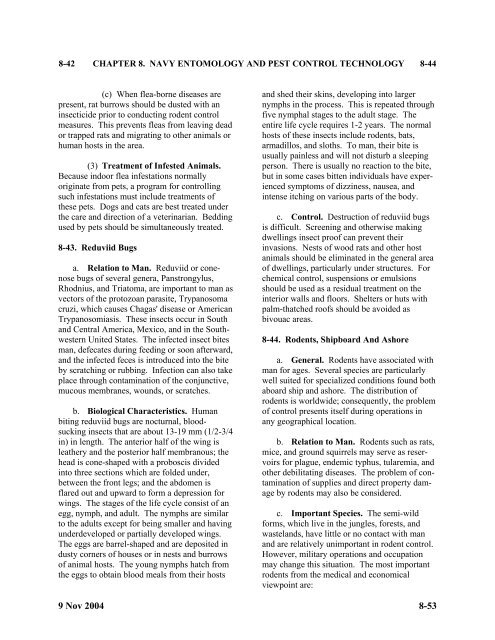NAVMED P-5010-8 - Navy Medicine - U.S. Navy
NAVMED P-5010-8 - Navy Medicine - U.S. Navy
NAVMED P-5010-8 - Navy Medicine - U.S. Navy
You also want an ePaper? Increase the reach of your titles
YUMPU automatically turns print PDFs into web optimized ePapers that Google loves.
8-42 CHAPTER 8. NAVY ENTOMOLOGY AND PEST CONTROL TECHNOLOGY 8-44<br />
(c) When flea-borne diseases are<br />
present, rat burrows should be dusted with an<br />
insecticide prior to conducting rodent control<br />
measures. This prevents fleas from leaving dead<br />
or trapped rats and migrating to other animals or<br />
human hosts in the area.<br />
(3) Treatment of Infested Animals.<br />
Because indoor flea infestations normally<br />
originate from pets, a program for controlling<br />
such infestations must include treatments of<br />
these pets. Dogs and cats are best treated under<br />
the care and direction of a veterinarian. Bedding<br />
used by pets should be simultaneously treated.<br />
8-43. Reduviid Bugs<br />
a. Relation to Man. Reduviid or conenose<br />
bugs of several genera, Panstrongylus,<br />
Rhodnius, and Triatoma, are important to man as<br />
vectors of the protozoan parasite, Trypanosoma<br />
cruzi, which causes Chagas' disease or American<br />
Trypanosomiasis. These insects occur in South<br />
and Central America, Mexico, and in the Southwestern<br />
United States. The infected insect bites<br />
man, defecates during feeding or soon afterward,<br />
and the infected feces is introduced into the bite<br />
by scratching or rubbing. Infection can also take<br />
place through contamination of the conjunctive,<br />
mucous membranes, wounds, or scratches.<br />
b. Biological Characteristics. Human<br />
biting reduviid bugs are nocturnal, bloodsucking<br />
insects that are about 13-19 mm (1/2-3/4<br />
in) in length. The anterior half of the wing is<br />
leathery and the posterior half membranous; the<br />
head is cone-shaped with a proboscis divided<br />
into three sections which are folded under,<br />
between the front legs; and the abdomen is<br />
flared out and upward to form a depression for<br />
wings. The stages of the life cycle consist of an<br />
egg, nymph, and adult. The nymphs are similar<br />
to the adults except for being smaller and having<br />
underdeveloped or partially developed wings.<br />
The eggs are barrel-shaped and are deposited in<br />
dusty corners of houses or in nests and burrows<br />
of animal hosts. The young nymphs hatch from<br />
the eggs to obtain blood meals from their hosts<br />
9 Nov 2004<br />
and shed their skins, developing into larger<br />
nymphs in the process. This is repeated through<br />
five nymphal stages to the adult stage. The<br />
entire life cycle requires 1-2 years. The normal<br />
hosts of these insects include rodents, bats,<br />
armadillos, and sloths. To man, their bite is<br />
usually painless and will not disturb a sleeping<br />
person. There is usually no reaction to the bite,<br />
but in some cases bitten individuals have experienced<br />
symptoms of dizziness, nausea, and<br />
intense itching on various parts of the body.<br />
c. Control. Destruction of reduviid bugs<br />
is difficult. Screening and otherwise making<br />
dwellings insect proof can prevent their<br />
invasions. Nests of wood rats and other host<br />
animals should be eliminated in the general area<br />
of dwellings, particularly under structures. For<br />
chemical control, suspensions or emulsions<br />
should be used as a residual treatment on the<br />
interior walls and floors. Shelters or huts with<br />
palm-thatched roofs should be avoided as<br />
bivouac areas.<br />
8-44. Rodents, Shipboard And Ashore<br />
a. General. Rodents have associated with<br />
man for ages. Several species are particularly<br />
well suited for specialized conditions found both<br />
aboard ship and ashore. The distribution of<br />
rodents is worldwide; consequently, the problem<br />
of control presents itself during operations in<br />
any geographical location.<br />
b. Relation to Man. Rodents such as rats,<br />
mice, and ground squirrels may serve as reservoirs<br />
for plague, endemic typhus, tularemia, and<br />
other debilitating diseases. The problem of contamination<br />
of supplies and direct property damage<br />
by rodents may also be considered.<br />
c. Important Species. The semi-wild<br />
forms, which live in the jungles, forests, and<br />
wastelands, have little or no contact with man<br />
and are relatively unimportant in rodent control.<br />
However, military operations and occupation<br />
may change this situation. The most important<br />
rodents from the medical and economical<br />
viewpoint are:<br />
8-53
















